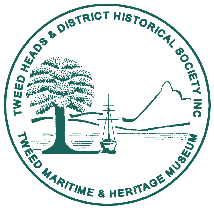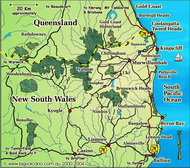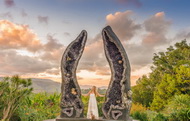Ships sunk off the Australian Coast 1939 - 1945
Photos © by Big Volcano TM&M and graphics courtesy of THDHS
Walk of Remembrance and Centaur Memorial
The Walk of Remembrance and Centaur Memorial is located on the headland at Point Danger, straddling the New South Wales and Queensland state border at the twin towns of Coolangatta and Tweed Heads.
As well as the Memorial Walk and extensive coastal views, the headland features Australia's first laser powered lighthouse, including an impressive memorial to Captain James Cook (incorporating ballast from the HM Bark Endeavour), and is a popular although briefly visited attraction, by those unfamiliar with the significance of the structures they view.
The Silent War
The following text [below] is © Copyright 2001 and reproduced with the kind permission of Bill Bainbridge of Tweed Heads and District Historical Society Inc, from the booklet "Walk of Remembrance and Centaur Memorial, Point Danger - Coolangatta Queensland Australia".
The Walk
of Remembrance and Centaur Memorial honours the ships
and the brave men and women who gave up their lives for
Australia.
During the Second World War, 41 allied naval and merchant ships were sunk off Australia's coast by enemy action. Hundreds of service personnel and merchant seamen were killed in these tragedies.
Few people today are aware of the war at sea which raged along the Australian coastline during World War II. A total of forty-one allied ships were sunk adjacent to our shoreline by the actions of mine laying German surface raiders (Pinquin, Atlantis, and Kormoran) and Japanese submarines.
Naval and merchant seamen were losing their lives only a few kilometres beyond the beaches. This silent war was kept from the knowledge of the Australian public at the time to prevent panic and the loss of morale.
Japanese Submarines
Most attacks took place in the years 1942 to 1944 when Japanese submarines operating from the forward base of occupied Guam prowled the eastern and northern seaboard.
These were large vessels, often equipped with a small spotting aircraft which flew reconnaissance flights over Newcastle and Sydney. They were 1-21, 1-24, 1-27, 1-76, 1-77, 1- 181 and others.
By day they hid at sea beyond the continental shelf in deep water and approached the coast by night or in rough weather to harry shipping.
AHS Centaur and HMAS Sydney
The most tragic loss on the eastern coast was the torpedoing of the hospital ship, AHS Centaur on 14 May 1943 with the loss of 268 lives.
The loss on 19 November 1941 of the light cruiser HMAS Sydney off Geraldton, Western Australia with the loss of 645 naval seamen was the most severe.
Merchant Seamen Losses
However the lives of merchant seamen were often forfeited.
The Iron Crown, a BHP ore carrier sank in one minute after being struck by a torpedo off the south coast of Gippsland Victoria, taking 37 seamen to the bottom with her.
The Wollongbar, a North Coast Steam Navigation vessel, sunk off Coffs harbour, took the lives of 32 merchant seamen.
The others listed [in detail in the booklet] will show the great loss of life which ensued from these attacks.
Most shipping sunk near our coast by aircraft happened in the early stages of the war with Japan. These occurred mainly off the northern Australian mainland in 1942. Many losses occurred in the air raids on Darwin and surrounding seas.
Tweed Heads fisherman, Claude Edds, spotted a Japanese submarine a few miles to sea off Point Danger in 1943 which he reported to authorities.
If you are using this booklet* as you are doing the "Walk", commence at the Southern end of the path, at the bottom of the steps leading down from the Captain Cook Memorial and Lighthouse.
Walk of Remembrance and Centaur Memorial Opening
The Walk of Remembrance was unveiled on 14 May 1993 by the Minister for Veteran Affairs, the Hon. John Faulkener.
It was opened conjointly with the Centaur Memorial which commemorated the fiftieth anniversary of the sinking of the hospital ship "Centaur" by the Japanese submarine 1177 on that date in 1943 off Moreton Island, with the loss of 268 lives.
A total of forty-one allied ships were sunk adjacent to our shoreline by the actions of mine laying German surface raiders (Pinquin, Atlantis, and Kormoran) and Japanese submarines.
The Walk was an initiative of the Centaur Commemoration Committee, who raised the finance to erect the Centaur Memorial. They approached the Gold Coast City Council to supply the plaques and the site for the walk.
The fence which encircled the headland became the venue for the plaques which were attached at intervals along its length.
The Council has since maintained the plaques. Mr David Jeanes, who was secretary of the Centaur Commemoration Committee, gathered the information regarding the shipping from various sources including the National War Memorial Archives to confirm the accuracy of information inscribed on each plaque.
The Booklet
* "Walk of Remembrance and Centaur Memorial, Point Danger - Coolangatta Queensland Australia" is available from Tweed Heads and District Historical Society Inc. A5, 16 pages. $3.00 plus postage Tel: (07) 5536 8625.

References and Readings
Walk of Remembrance and Centaur Memorial,
Point Danger - Coolangatta Queensland Australia
Front Cover Illustration: Warren Keats OAM
Research: Gwynneth Broomhall
Typing & Layout: Margaret Lutton
First published 2001.
ISBN 0-9579112-1-1
Published by: Tweed
Heads and District Historical Society Inc.
PO Box 839
Tweed Heads NSW 2485
Photos © by Big Volcano TM&M and graphics courtesy of THDHS
Google Ads


